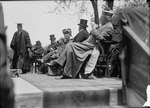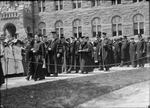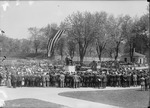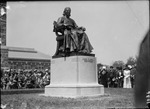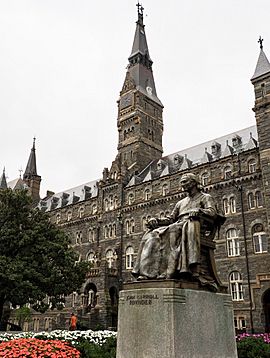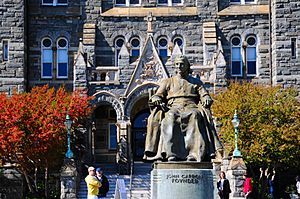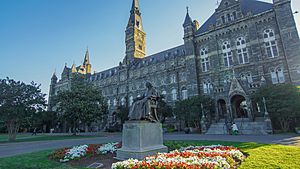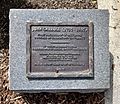Statue of John Carroll facts for kids
Quick facts for kids Statue of John Carroll |
|
|---|---|
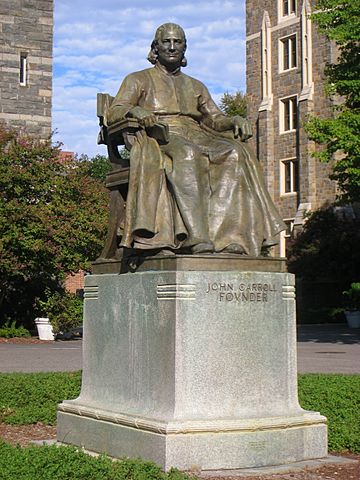
The statue in 2010
|
|
| Artist | Jerome Connor |
| Completion date | May 4, 1912 |
| Medium | Bronze sculpture |
| Subject | John Carroll |
| Dimensions | 437 cm × 282 cm × 353 cm (14 ft 4 in × 9 ft 3 in × 11 ft 7 in) |
| Location | Washington, D.C., United States |
| Owner | Georgetown University |
The Statue of John Carroll is a sculpture by Jerome Connor. It honors Archbishop John Carroll. He founded Georgetown University. He was also the first Catholic bishop in the United States.
The statue is located at Georgetown University in Washington, D.C.. It stands in front of Healy Hall. The statue shows a bronze sculpture of Carroll. It sits on a granite base. The whole monument is over 14 feet (4.3 m) tall. It was revealed in 1912. A big three-day party celebrated its opening. Many important people attended. These included bishops, members of Congress, and judges. Students at the university have a fun tradition. They like to sit in the archbishop's lap.
Contents
The Story of the Statue
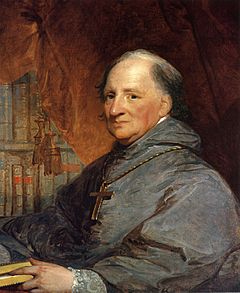
After Healy Hall was finished, a spot was saved. This spot was for a statue of Georgetown's founder. On January 23, 1909, a priest named Rev. John A. Conway shared a wish. He wanted a monument for John Carroll. Carroll founded Georgetown University. He was also the first Catholic Bishop in the U.S. He later became the first Archbishop of Baltimore. This is the oldest Catholic area in the country.
People started raising money that year. They collected $7,000 for the statue. This money would be worth much more today.
The Big Unveiling Day
A three-day celebration started on May 3, 1912. It was for the statue's arrival. On the first night, students held a party. They had music and speeches. The statue was officially shown to the public on May 4, 1912.
But there was a secret! The company making the statue said it wouldn't be ready. So, Georgetown used a brown-painted plaster copy. They put it on the base instead. Thousands of people came to the ceremony. They did not know it was a copy. This secret was kept until 1940. A worker named Brother James Harrington told the university newspaper.
- Dedication ceremony on May 4, 1912
The ceremony began with a parade. Clergy, government officials, and teachers marched. Chief Justice Edward Douglass White officially gave the statue to the university. He spoke about John Carroll. He also talked about Carroll's brother, Charles Carroll of Carrollton. He signed the Declaration of Independence. White said that Christian ideas helped found both Georgetown and the U.S. After his speech, the American flag was lifted. This showed the statue. The United States Marine Band played music.
Many other important people gave speeches. These included Cardinal James Gibbons and Speaker of the House Champ Clark. The Attorney General, George W. Wickersham, also spoke. President William Howard Taft was supposed to be there. But he had to go to a memorial service. His close helper died on the Titanic. So, Wickersham spoke for him.
The next day, celebrations continued. More than 300 alumni gathered. Rev. Conway spoke about Carroll's love for his country and his faith. Other leaders also spoke. Later, a special church service was held. A speaker talked about Carroll's ideas. He said Carroll influenced the U.S. Constitution. Specifically, he helped make sure people could not be tested on their religion for public jobs. The parties ended with a reception.
Several weeks later, the real bronze statue arrived. It replaced the plaster copy during the night.
What the Statue Looks Like
The Bishop John Carroll statue is on a round grassy area. This area is between Healy Hall and the university's front gates. It is called Healy Circle. The statue was made by an Irish artist named Jerome Connor. He was trained to carve stone.
The bronze sculpture shows John Carroll sitting in a chair. His hands rest on the arms of the chair. He looks slightly to his right. He seems to be deep in thought. In his right hand, he holds a book. His finger marks a page in it. Carroll wears Jesuit church clothes. They spread over the chair. His hair is brushed back from his face. It reaches his collar. Under his chair, there is a pile of books. This was inspired by another statue. The John Harvard statue at Harvard University also has books.
The bronze part of the statue is 82 inches (210 cm) long. It is 41 inches (100 cm) wide and 70 inches (180 cm) tall. The sculpture sits on a base made of North Carolina granite. This base is 57 inches (140 cm) long. It is 70 inches (180 cm) wide and 102 inches (260 cm) tall. So, the whole statue is 11 feet 7 inches (3.53 m) long. It is 9 feet 3 inches (2.82 m) wide. And it stands 14 feet 4 inches (4.37 m) tall.
On the front of the base, it says: "JOHN CARROLL" and "FOUNDER". On the back, it says: "PRIEST" and "PATRIOT PRELATE". On the right side, near the bottom, you can see the artist's name. It says "Jerome Conner – 1912". This is when it was finished.
Fun Student Traditions
There's a common story about the statue. People thought the space under the chair was filled in 1923. This was supposedly to stop students from putting things there. But this story is not true. The books were always part of the statue. Once, students even painted the statue red!
A popular tradition for graduating students is to climb the statue. They sit in the lap of John Carroll.
The statue has also been in movies. You might have seen it in The Exorcist or Scorpio.
Images for kids
See also
 In Spanish: Estatua de John Carroll para niños
In Spanish: Estatua de John Carroll para niños


